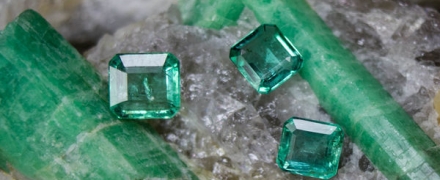open 10 am - 7 pm
laboratory is closed
Emerald and beryl - what's the difference?

To answer, we need to distinguish between two concepts - the mineral species and variety.
A mineral species is a group of minerals with a similar chemical composition and the same crystal structure.
Mineral varieties are minerals of a certain type and differing in their physicochemical properties or the composition of impurities.
Now back to our question. Beryl is a mineral species, belongs to the class of silicates and has the formula Al2 [Be3 (Si6O18)]. In connection with the possibility of entering into the structure of beryl various impurities, it has several varieties that differ in colors. One of them is an emerald, the green color of which is caused by the replacement of Al in the structure of beryl with Cr or V and Fe.
В геммологической практике бывают весьма увлекательные случаи с диагностикой ювелирных вставок
Но помимо редкости цвета и высокой стоимости таких камней, многие розовые камни выделяются одной замечательной особенностью – они проявляют плеохроизм, то есть в зависимости от положения осмотра камня он может иметь дополнительные оттенки – оранжевый или пурпурный.
Currently, gemstones are produced by two fundamentally different technological methods - the High Pressure - High Temperature method (“HPHT”, High-pressure & High-temperature) and the Chemical Vapor Deposition (“CVD”, Chemical vapor deposition) method. The "HPHT" method is the most tested classical synthesis method, which can be used both carbon deposition on diamond from flux melts and catalytic reactions. In "CVD" synthesis, diamond growth occurs on a seed during carbon deposition mainly from a gaseous medium at relatively low temperatures and pressures.
Jewelry and precious stones are just such a category of goods, when buying which you need to pay attention to many criteria.
Sogdianite is a rather rare mineral and more often it can be found as a collection material (moreover, in systematic collections), and it is extremely rare in jewelry.






